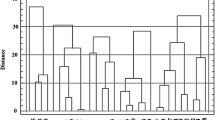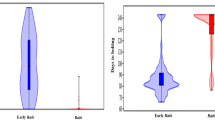Summary
The agronomic performance of 9 doubled haploid (DH) lines of Chinese Spring, 6 DH lines of Hope, 14 DH lines of the single chromosome substitution line Chinese Spring (Hope 5 A) and their respective parents was analyzed under field conditions. Seventeen Chinese Spring DH lines derived from wheat x Hordeum bulbosum crosses were also included for comparison. No significant variation was detected in either population of Chinese Spring DH lines and neither DH population differed from its parent. The Hope DH lines differed significantly for tiller biomass, spikelet number per ear, ear grain weight and 50-grain weight. However, all the variation could be attributed to the poor performance of only one line. Chinese Spring (Hope 5 A) DH lines showed significant variation for ear emergence time, but this was probably due to genetic heterogeneity in the parental stock. Overall, the results suggest that most DH lines produced by the wheat x maize method resemble their wheat parent, and that the variation induced in DH production is likely to be similar to that found in DHs from wheat x Hordeum bulbosum crosses.
Similar content being viewed by others
References
Baenziger PS, Wesenberg GW, Schaeffer G, Galun W, Feldman M (1983) Variation among anther culture derived doubled haploid lines of “Kitt” wheat. In: Sakamoto S (ed) Proc 6th Int Wheat Genet Symp, Kyoto University, Japan, pp 572–582
Baenziger PS, Wesenberg DM, Smail VM, Alexander WL, Schaeffer GW (1989) Agronomic performance of wheat doubled-haploid lines derived from cultivars by anther culture. Plant Breed 103:101–109
Carver BF, Johnson BB (1989) Partitioning of variation derived from tissue culture of winter wheat. Theor Appl Genet 78:405–410
Comeau A, Plourde A, St Pierre CA, Nadeau P (1988) Production of doubled haploid wheat lines by wheat x maize hybridization. Genome 30 [Suppl 1]:482 (Abstract)
De Buyser J, Henry Y, Taleb G (1985) Wheat androgenesis: cytogenetical analysis and agronomic performance of doubled haploids. Z Pflanzenzucht 95:23–34
Falk DE, Kasha KJ (1981) Comparisons of the crossability of rye (Secale cereale) and Hordeum bulbosum onto wheat (Triticum aestivum). Can J Genet Cytol 23:81–88
Falk DE, Kasha KJ (1983) Genetic studies of the crossability of hexaploid wheat with rye and Hordeum bulbosum. Theor Appl Genet 64:303–307
Laurie DA (1989) Factors affecting fertilization frequency in crosses of Triticum aestivum cv “Highbury” x Zea mays cv “Seneca 60”. Plant Breed 103:133–140
Laurie DA, Bennett MD (1987) The effect of the crossability loci Kr1 and Kr2 on fertilization frequency in hexaploid wheat x maize crosses. Theor Appl Genet 73:403–409
Laurie DA, Bennett MD (1988a) Chromosome behaviour in wheat x maize, wheat x sorghum and barley x maize crosses. In: Brandham PE (ed) Kew Chromosome Conference III. Her Majesty's Stationary Office, London, pp 167–177
Laurie DA, Bennett MD (1988b) The production of haploid wheat plants from wheat x maize crosses. Theor Appl Genet 70:100–105
Laurie DA, Bennett MD (1989) The timing of chromosome elimination in hexaploid wheat x maize crosses. Genome 32:953–961
Laurie DA, O'Donoughue LS, Bennett MD (1990) Wheat x maize and other wide sexual hybrids: their potential for crop improvement and genetic manipulation. In: Gustafson JP (ed) Gene manipulation in plant improvement II, Proc 19th Stadler Genet Symp. Plenum Press, New York, pp 95–126
Liu CJ, Gale MD (1989a) The chromosomal location of a third set of malate dehydrogenase loci, Mdh-3, in wheat, barley and related species. Theor Appl Genet 78:349–352
Liu CJ, Gale MD (1989 b) Ibf-1 (Iodine binding factor), a highly variable marker system in the Triticeae. Theor Appl Genet 77:233–240
Marburger JE, Jauhar PP (1989) Agronomic, isozyme, and cytogenetic characteristics of “Chris” wheat doubled haploids. Plant Breed 103:73–80
Sharp PJ, Desai S, Gale MD (1988) Isozyme variation and RFLPs at the β-amylase loci in wheat. Theor Appl Genet 76:691–699
Sitch LA, Snape JW (1986) Doubled haploid production in winter wheat and triticale genotypes. Euphytica 35:1045–1051
Sitch LA, Snape JW (1987 a) Factors affecting haploid production in wheat using the Hordeum bulbosum system. 1. Genotypic and environmental effects on pollen grain germination, pollen tube growth and frequency of fertilization. Euphytica 36:483–496
Sitch LA, Snape JW (1978b) Factors affecting haploid production in wheat using the Hordeum bulbosum system. 2. The effect of the timing of pollination. Euphytica 36:497–504
Sitch LA, Snape JW (1987c) Factors affecting haploid production in wheat using the Hordeum bulbosum system. 3. Post-fertilization effects on embryo survival. Euphytica 36:763–773
Snape JW, Chapman V, Moss J, Blanchard CE, Miller TE (1979) The crossabilities of wheat varieties with Hordeum bulbosum. Heredity 42:291–298
Snape JW, Sitch LA, Simpson E, Parker BB (1988) Tests for the presence of gametoclonal variation in barley and wheat doubled haploids produced using the Hordeum bulbosum system. Theor Appl Genet 75:509–513
Suenaga K, Nakajima K (1989) Efficient production of haploid wheat (Triticum aestivum) through crosses between Japanese wheat and maize (Zea mays). Plant Cell Rep 8:263–266
Winzeler H, Schmid J, Fried PM (1987) Field performance of androgenetic doubled haploid spring wheat lines in comparison with lines selected by the pedigree system. Plant Breed 99:41–48
Author information
Authors and Affiliations
Additional information
Communicated by G. Wenzel
Rights and permissions
About this article
Cite this article
Laurie, D.A., Snape, J.W. The agronomic performance of wheat doubled haploid lines derived from wheat x maize crosses. Theoret. Appl. Genetics 79, 813–816 (1990). https://doi.org/10.1007/BF00224250
Received:
Accepted:
Issue Date:
DOI: https://doi.org/10.1007/BF00224250




